Learn how to purchase, cook, and eat fresh artichokes using these simple and very easy instructions. Artichokes might seem a little intimidating if no one has shown you how to prepare and eat them. Did you know that there is an etiquette to eating artichokes? Don’t worry, they are very easy to eat properly. Just follow my easy instructions below.
Learn about the History and Legends of Artichokes and also check out these easy to prepare and so delicious Artichoke Recipes.
When fresh artichokes are in season, I could eat them everyday. This simple preparation is my favorite way to serve them. Artichokes are beautiful to look at and also make an impressive starter for your dinner party. Instead of butter for dipping, I use an mayonnaise and mustard dip (see recipe below).
Artichoke Facts:
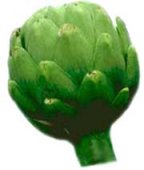 The artichoke is a perennial vegetable in the thistle group of the sunflower family and is believed to be a native of the Mediterranean and the Canary Islands. The “vegetable” that we eat is actually the plant’s flower bud. If allowed to flower, the blossoms measure up to seven inches in diameter and are a beautiful violet-blue color. There are more than 140 artichoke varieties but less than 40 are grown commercially. In full growth, the plant spreads to cover an area about six feet in diameter and reaches a height of three to four feet. Artichokes are available twelve months a year with the peak season in the spring and fall.
The artichoke is a perennial vegetable in the thistle group of the sunflower family and is believed to be a native of the Mediterranean and the Canary Islands. The “vegetable” that we eat is actually the plant’s flower bud. If allowed to flower, the blossoms measure up to seven inches in diameter and are a beautiful violet-blue color. There are more than 140 artichoke varieties but less than 40 are grown commercially. In full growth, the plant spreads to cover an area about six feet in diameter and reaches a height of three to four feet. Artichokes are available twelve months a year with the peak season in the spring and fall.
Artichoke fields are maintained in perennial culture for five to ten years. Each cropping cycle is initiated by “cutting back” the tops of the plants several inches below the soil surface to stimulate development of new shoots. The operation called “stumping,” is timed to regulate the new harvest season.
Today most artichokes grown worldwide are cultivated in France, Italy, and Spain, while California provides nearly 100 percent of the United States crop. In fact, one hundred percent of all artichokes grown commercially in the United States are grown in California.
Also learn about the History and Legends of Artichokes and also check out Artichoke Recipes.
Purchasing Artichokes:
One medium to large artichoke will yield approximately 2 ounces of edible flesh.
If the artichoke feels heavy for its size and squeaks when squeezed, you have found a fresh artichoke.
Select artichoke globes that are deep green, with a tight leaf formation, and those that feel heavy for their size. A good test of freshness is to press the leaves against each other which should produce a squeaking sound. Browning of the tips can indicate age, but can also indicate frost damage.
Frost-kissed Artichokes: Fall and winter artichokes may be darker or bronze-tipped or have a whitish, blistered appearance due to exposure to light frost. This is called “winter-kissed.” These frost-kissed artichokes are considered to be the most tender with intense flavor. Look for tender green on the inside of petals. Frost-kissed artichokes are available sporadically, when temperatures in the growing regions dip below 32 degrees. If your are a “choke” lover, you will want to snatch these babies up whenever you see them. To tell the difference between an artichoke that has been frost-kissed and one that has been just plain abused, try to peel the brownish flakes with your fingernail. If the flakes peel off, it a frost-kissed artichoke. Avoid artichokes which are wilting, drying or have mold.
Storing Artichokes: To store fresh artichokes at home, sprinkle them with a little water and refrigerate in an airtight plastic bag. Do no wash before storing. They should last a week when stored properly.
How To Prepare Artichokes:
Wash artichokes under cold, running water. Pull off lower petals and cut off bottom stems (cut flush with the base). Cut off about 1/2 inch of the pointed top of the artichoke. Trim tips of leaves with scissors to remove thorns. Dip in lemon juice to preserve color.
TIP: Always use a stainless-steel knife and a stainless-steel or glass pot. Iron or aluminum will turn artichokes an unappetizing blue or black. For the same reason, never let aluminum foil come in contact with artichokes.
Wash under cold, running water. Pull off lower petals and cut off stem.
Cut off about 1/2 inch of the pointed top of the artichoke. Trim tips of leaves with scissors to remove thorns. Dip in lemon juice to preserve color.
How To Cook Artichokes:
Cooking time depends on how large the artichoke is – the larger the artichoke, the longer it takes to cook.
Boiling Method: Stand up the prepared artichoke in a deep saucepan or pot with 3-inches boiling water (if desired, oil, lemon juice and/or seasonings can be added to cooking water). Cover with a lid and gently boil approximately 25 to 40 minutes, depending on size of the artichokes, or until a petal near the center pulls out easily. When done cooking, remove from the pot and stand artichoke upside down on a rack to drain.
Steaming Method: Place prepared artichoke on a rack above 1- to 2-inches of boiling water. Cover and steam approximately 25 to 45 minutes, depending on size, or until a petal near the center pulls out easily.
How To Prepare Artichoke Hearts:
Into a large bowl, squeeze the juice of 1 lemon into 1 quart of the water. As you prepare and cut your artichokes, dip them into the lemon/water to prevent discoloring (oxidizing).
Using a sharp knife, cut the stems off of the artichokes even with the bottoms.
Pull off and discard all leaves.
Using a small pairing knife, trim the remaining dark green surfaces at the base of the artichoke, including the stalk.
The choke (hairy fibers in the center of the artichoke) need to be removed. Using a melon baller or a spoon; remove and discard the choke.
Trim the bottoms and put the trimmed artichoke hearts in the lemon water.
Baby Artichokes – How To Prepare Baby Artichokes:
Baby artichokes are not a separate variety but merely smaller versions of larger artichokes. Their size comes from their location on the artichoke plant. They are picked from the lower parts of the artichoke plant where the plant fronds protect them from sun, in effect stunting their growth.
Small artichokes, which are being shipped fresh more frequently today, make a savory appetizer, salad or vegetable accompaniment when marinated, either whole or cut lengthwise in halves. They are also delicious in poultry, beef, pork or lamb stews.
Baby artichokes are sold in plastic bags or loose. Their size can vary from walnut to jumbo egg size. Size is no indication of age. (Some babies are bigger than other babies!) Choose baby artichokes that are firm and heavy for their size. Most have no fuzzy choke.
Bend back lower, outer petals of artichokes until they snap off easily near base. Continue doing this until you reach a point where the leaves are half green (at the top) and half yellow (at the bottom).
Using a sharp stainless steel knife, cut off top third of artichokes or just below the green tips of the petals. Pare all remaining dark green areas from bases. Cut off stems.
Halve or quarter as desired. If center petals are purple or pink remove center petals and fuzzy centers. Dip or rub all surfaces with lemon juice.
Cook as directed in recipes.
How To Make Artichoke Cups for Stuffing:
Some recipes call for the choke to be removed to make a “cup” for stuffing. It is easier to do this after the whole artichoke has been cooked.
Prepare the vegetable as for serving whole. Boil, steam, or microwave, then let stand until cool enough to handle.
Spread the outer leaves apart, pull out the petals covering the choke, and use a teaspoon to scrape out the choke. The artichoke cup can be stuffed and then either served as is or baked with the stuffing.
Etiquette of Eating Whole Artichokes – How To Eat Artichokes:
Did you know that there is an etiquette to eating artichokes? Don’t worry, they are very easy to eat properly. Just follow my easy instructions below:
It is both proper and polite to pluck the leaves with your fingers, leaving fork and knife aside.
Pull off a leaf (holding it by the pointed end). Put the other end in your mouth and pull it between your teeth, scraping the length of the leaf (the edible portion of the leaves becomes greater as you get closer to the center of the artichoke).
Just before you get to the very center, leaves will become almost white with purple tips. Be careful of these leaves because their purple ends are prickly.
When the leaves are pulled, you will be left with the base (the heart crowned with a fuzzy patch). You have now reached the best part of all, the very reason for eating artichokes – the heart.
Carefully scoop away the fuzzy stuff with your knife or spoon (though a properly prepared artichoke will already have the choke removed). With knife and fork, cut bites from the heart like pieces of prime beef fillet.
If you’re provided with a dip such as a vinaigrette or mayonnaise, put a small part of the edible portion of the leaf in the dip and scrape with your teeth as directed above. Do not overdo it on the dip or you will not taste the artichoke.
- 2 tablespoons light mayonnaise
- 1 teaspoon prepared mustard
- 2 large artichokes
- 1 tablespoon lemon juice
-
In a small bowl, combine mayonnaise and mustard. Cover and refrigerate until ready to serve.
-
Wash artichokes under cold, running water. Pull off lower petals and cut off bottom stems (cut flush with the base). Cut off about 1/2 inch of the pointed top of the artichoke. Trim tips of leaves with scissors to remove thorns. Dip in lemon juice to preserve color.
-
TIP: Always use a stainless-steel knife and a stainless-steel or glass pot. Iron or aluminum will turn artichokes an unappetizing blue or black. For the same reason, never let aluminum foil come in contact with artichokes.
-
In a large pot (big enough to hold the artichokes in a single layer), add approximately 2 cups of water and the remaining lemon juice; bring to a boil.
-
Place the prepared artichokes in the boiling water, cover with lid, reduce heat to simmer, and let cook for approximately 20 to 40 minutes (depending on size). The artichokes are done when the leaves pull away easily. Remove artichokes from the boiling water with tongs and drain them upside down in a colander (after cooking, artichokes can be stored in an airtight container for a maximum of 3 days). Bring to room temperature before serving. Serve warm or cool with mayonnaise/mustard dip.
-
Makes 2 servings.
Check out my Nutritional Chart for fat grams, carbohydrate grams, and calories for all your favorite foods.
Categories:
Artichoke Cooking Lessons - Cooking 101 Vegetable Cooking Lessons Vegetarian Recipe Collection
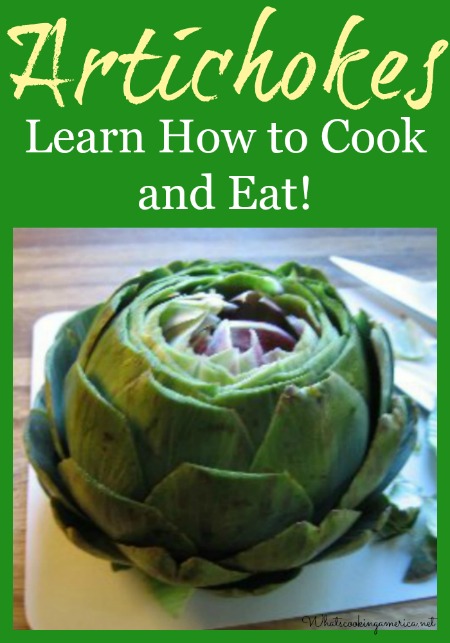
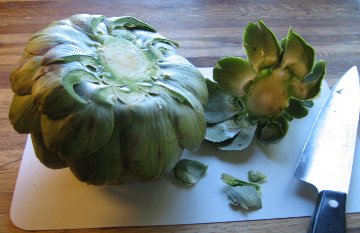
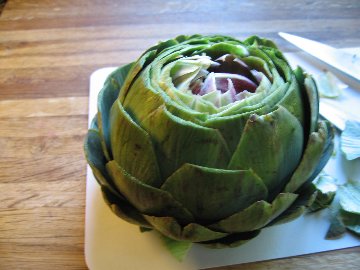
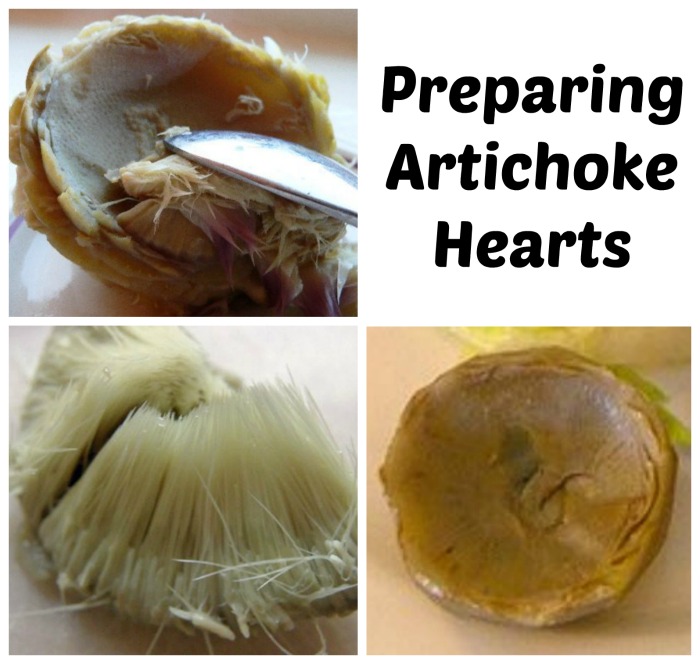
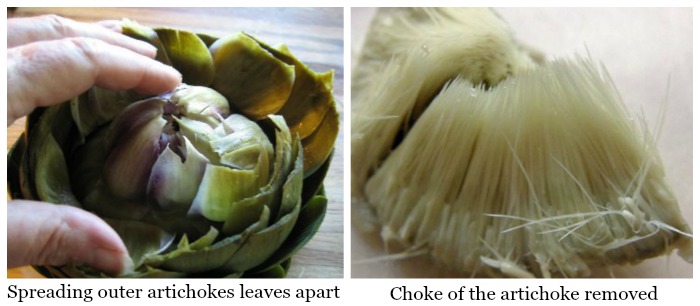
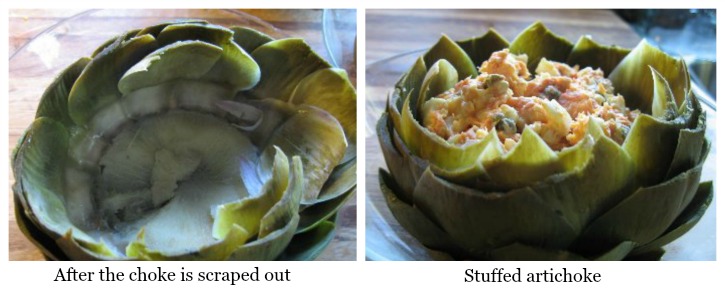
6 Responses to “Learn How To Cook and Eat Artichokes”
MorrisonCatherine
Thank you so much for the how to prepare and cook artichokes. I have been able to get quite a few ,
I’m able to go ahead and eat them fresh.You are quite welcome to post emails to me if you wish.
quite
Regards Catherine.
Brenda Grecco
I have cooked artichokes in my crock pot for 4 hours with a little bit of water in the bottom salt and pepper lemon juice, garlic and whatever seasonings I have on hand and they have come out great and full of flavor
Kimmy Garcia
Is it okay to eat the leaf instead of scraping with the teeth? 😮
JANICE ELLISON
I have removed the choke part of the artichoke both before and after cooking. Removing it after cooking is so much easier. I cut them in half, after steaming, remove the choke, then put on a hot bbq grill for ten minutes or until I get grill marks. Yumm!!
Katy
My favorite way of preparing artichokes is adding 1/4 to 1/2 cup of balsamic vinegar and garlic powder to the water the chokes are being cooked in. That, combined with a mayonnaise dip, is heaven!
Nancy
That sounds really good, I bet the flavor soaks in during cooking.